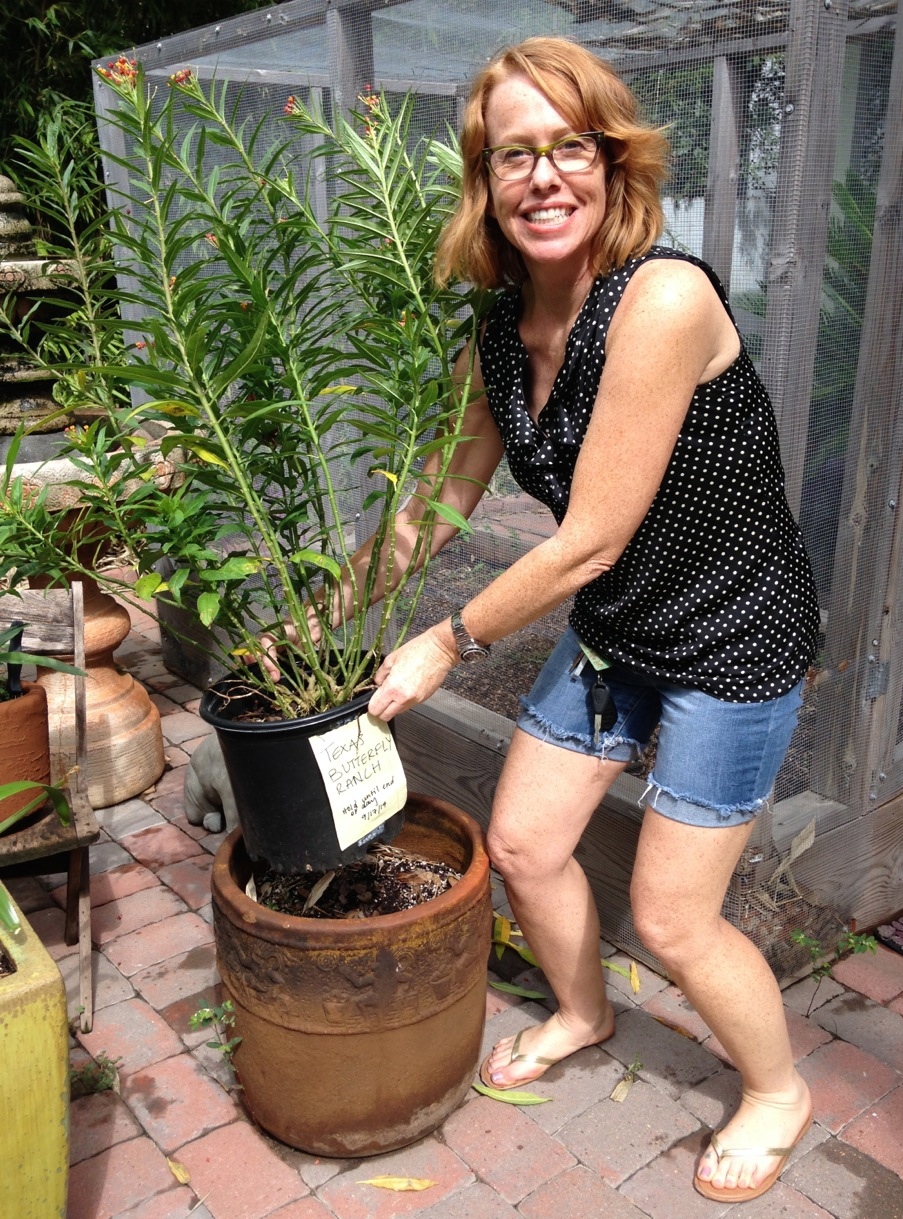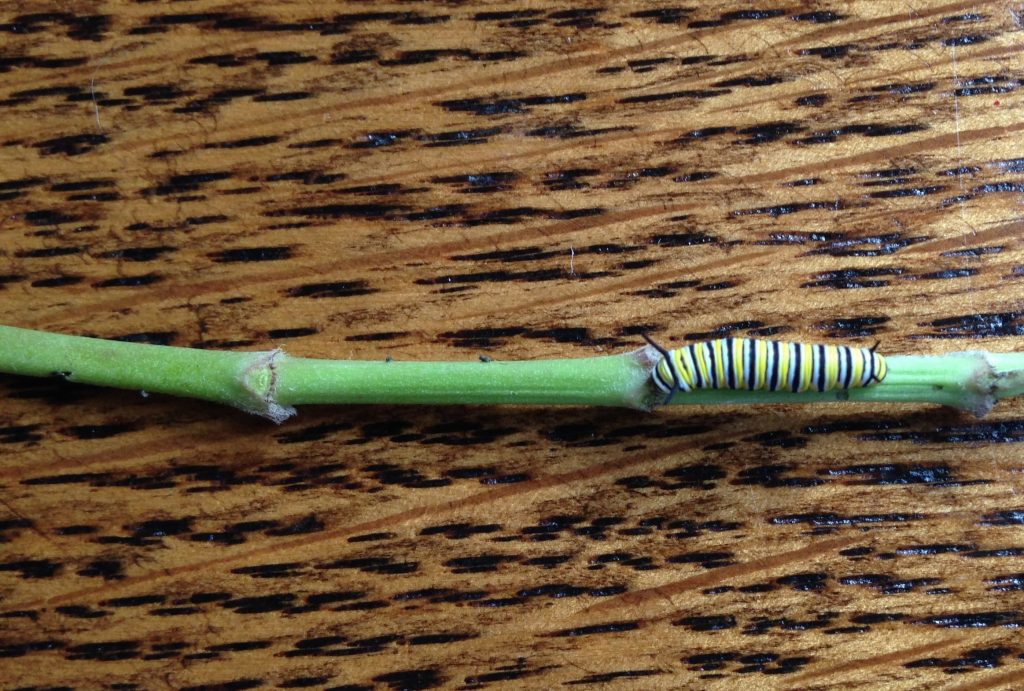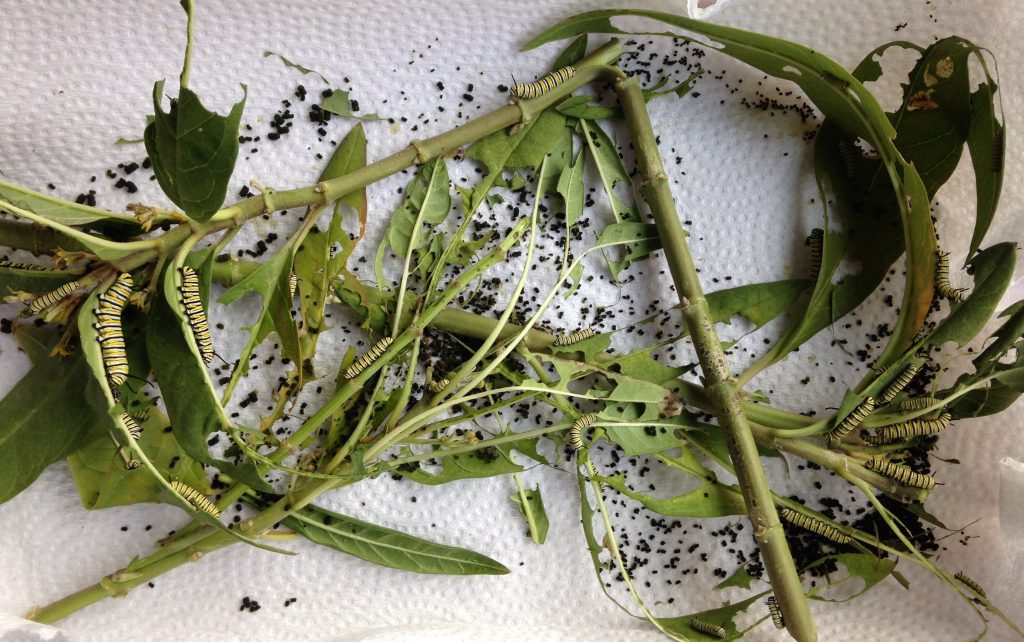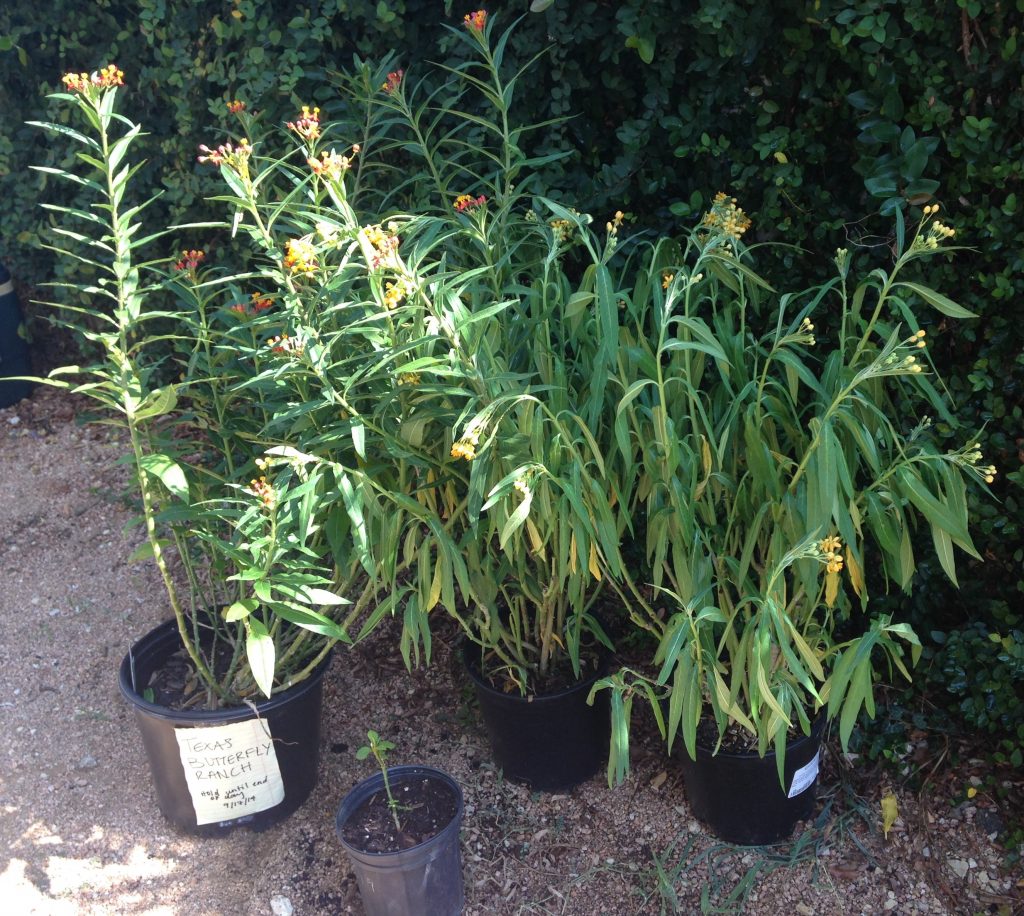It takes a village to keep the Monarch butterfly migration going.
Last week I discovered dozens of Monarch butterfly eggs at the ranch when a cold front pushed a vanguard pulse of migrants down to the Texas funnel. The early moving butterflies broke their reproductive diapause to lay hundreds of eggs. I collected more than 70 from Swamp milkweed, Asclepias incarnata, along the banks of the Llano River and dozens more from our downtown San Antonio garden.

Special delivery of milkweed by Tracy Idell Hamilton with an assist from Teresa Elliott. Photo by Teresa Elliott.
That’s the good news.
The problem: where would we get enough “clean” milkweed this late in the season to feed the hungry critters, who eat more than 2,000 times their birth weight in milkweed leaves? NOTE: “clean” milkweed is plant material that has never been sprayed with systemic pesticides, which routinely kill the caterpillars.
I’ve written before about the scarcity of chemical free milkweed, especially this time of year. In fact, we are exploring the idea of becoming a native, chemical free milkweed supplier. Please take our poll and let us know if you would support such an endeavor.

What’s for dinner? Hungry Monarch caterpillar got a special delivery of Austin milkweed just in time to morph to the next stage. Photo by Monika Maeckle
San Antonio nurseries all told similar stories: “Sorry, we’re out,” or “Yes, we have some, but can’t guaranteed that it’s never been sprayed.”
One nursery had milkweed, but couldn’t guarantee it had not been sprayed by the grower with systemic pesticides, which can linger in the leaves for months. And we all know how that turns out–just read one of our most read posts of all time, Desperately Seeking Milkweed, details the sorry stories of two friends who served pesticide laced milkweed to their hungry cats.

Dead Monarch caterpillars fall victim to pesticide laced milkweed. No thank you! Photo by Sharon Sander.
What to do?
Turn to the community, of course. In the case of Monarchs, that’s a broad collection of friends, family and acquaintances near and far. One of our favorite Austin nurseries, The Great Outdoors, almost always has a supply of chemical free milkweed on hand. A quick call to the native plant destination confirmed they had about a dozen large pots of clean, Tropical milkweed, Asclepias curassavica, left over from a spring shipment. The plants could provide the massive foraging and feasting buffet required to take our dozens of ravenous crawlers to the butterfly stage of their life cycle.
But drive 150 miles roundtrip to Austin from San Antonio on the clogged IH-35 on a busy Saturday to collect plants? Sigh. NOT very appealing.

Good thing my dear friend Teresa Elliott lives a few blocks from Great Outdoors and volunteered to pick up a few plants for me at $15.95 a pop. (Yeah, kind of expensive–but worth it.) Teresa wouldn’t even let me reimburse her. “I’m doing it for the cause,” she said.
Meanwhile, another good friend and Monarch tagging pal, Tracy Idell Hamilton, agreed to pick up the bushy bloomers since she was already in Austin attending the Texas Tribune Festival. Teresa’s house happened to be just a few blocks away from where Tracy was staying.

Such collaboration is commonplace in the sphere of the Monarch butterfly migration, where volunteers, citizen scientists, professional academics and entomologists routinely share data, tricks of the trade, and information to keep the migration going. It’s the nature of the passion.
Upon arriving home from a day of errands last Saturday, three “ginormous” milkweed plants waited at my door. The plants were mature, relatively aphid-free, and ready to be attacked by my hungry cats.

More, please! These hungry caterpillars outgrew their container and were ready for a bushy milkweed buffet. Photo by Monika Maeckle
The gang had been chomping happily on milkweed from my downtown garden, but even if we used every plant in the yard, it wouldn’t be enough to sustain them. For the first few days, my mom, Hilde Maeckle, would help me daily clean out the caterpillars temporary plastic container home of frass, or caterpillar poop, which can be monumental. We would wipe down the container, lay out fresh leaves for them, and leave them to munch.
But now they were getting too big and too crowded, so it was time to transfer them to the plants–which arrived just in time.

Thanks, ladies! “Ginormous” Tropical milkweed delivered to my door from Austin. Photo by Monika Maeckle
The caterpillars are now munching happily on these milkweeds, growing before our eyes. In a day or so we’ll transfer the plants with the caterpillars to a large netted cage, or “caterpillar condo” to keep them from wandering off. Eventually, each caterpillar will seek a quiet place, form an upside down “J” shape, then morph into a beautiful jade green chrysalis to hatch sometime during the second week in October, just as peak migration hits San Antonio. We look forward tagging and sending them on their way.
Thanks to all the friends, family, professional and citizen scientists near and far who work hard to sustain the seasonal miracle of the Monarch butterfly migration.
Related Posts:
- Desperately Seeking Milkweed: Milkweed Shortage Creates Butterfly Emergency
- Migration Update: Llano River EGGstravaganza
- How to Track the Monarch Butterfly Migration from Your Desk
- Monarch Butterflies Headed our Way in Apparent Rebound Season
- Llano River Ready for “Premigration Migration” of Monarch Butterflies
- How to Tag a Monarch Butterfly in Six Easy Steps
- Pollinator Power on the San Antonio River Walk
- 2014 Monarch Butterfly Migration: Worst Year in History or Hopeful Rebound?
- How to Raise Monarch Butterflies at Home, Part One
- First Lady Michelle Obama Plants First Ever Pollinator Garden at the White House
- Monarch Butterfly Numbers Plummet: will Migration become Extinct?
- NAFTA Leaders, Monsanto: Let’s Save the Monarch Butterfly Migration
- What does climate change mean for Monarch butterflies?
Like what you’re reading? Follow butterfly and native plant news at the Texas Butterfly Ranch. Sign up for email delivery, like us on Facebook, or follow us on Twitter, @monikam.


I like to plant dill in a container.Doesn’t that work just as well as milkweed?
Dill is a host plant for Black Swallowtails. Monarch butterflies do not use it. They need milkweeds that is their host plant.
That happened at the National Zoo in DC one time. The keeper a the butterfly exhibit needed milkweed. She got plenty! 🙂
When I have no cats and an abundance of healthy milkweed leaves, I have frozen leaves and even stems for future use. I just pick the leaves, wash, then lay them out side by side on paper towels. Then roll up paper towels and and put in a double baggy in the freezer. When I need it, I thaw a baggy and feed it to my instar 4’s and 5’s. It changes the consistency of the leaves, but the cats eat it very well! As it thaws, I stretch the leaves out and blot them really well then lay them flat in the containers and have no problems with them eating. Hope that helps!
Wow, great idea! Who knew? Thanks for sharing. –MM
I’m in Abilene, Texas. I have found dozens of milkweeds plants on my property. I have discovered 4 species I have identified–Asclepias asperula (Antelope horns), A. veridiflora (Wand or Green Comet), A. latifolia (Broadleaf), and A. oenotgeroides (Hierba de Zizotes). I have collected hundreds of seeds and turned them over to the Master Gardeners. Just picked 2 more pods this evening. I have planted some in my flowerbeds and am having good success.
I have located two other varieties, but haven’t been able to name them yet. I spoke with a botanist last night at Master Naturalist class to ask for help identifying them.
The Master Gardeners are making the seeds into seed balls and handing them out. I have also given seeds to members of my art club, church friends, Master Naturalists, etc.
I have lots of clean milkweed, but it is not in pots. It is growing at my shop (3 acres) and at my home (2 acres) and in my flower beds.
In the event of no milkweed and starving monarchs one can use pumpkin. Monarchs do eat the pumpkin but as it doesn’t give them the toxicity they need, I wouldn’t feed pumpkin unless in dire need.
Pretty! This was an incredibly wonderful post.
Thank you for supplying this info.
I’ve discovered 3 caterpillars on some A. curassavica–It’s November 7, are they going to eat, morph and move on, or is it too late? Thanks
i bought a milkweed from a nursery they told me it was sprayed, but they told me to spray it with a soapy water spray inside, wait until it dries then rinse and wait 24 hrs before putting it outside. I hope this works.
the picture above with the chrysalis says they are Monarchs, but several of them are Queens also.
You are correct that one of them is a Queen. Thanks for writing. –MM